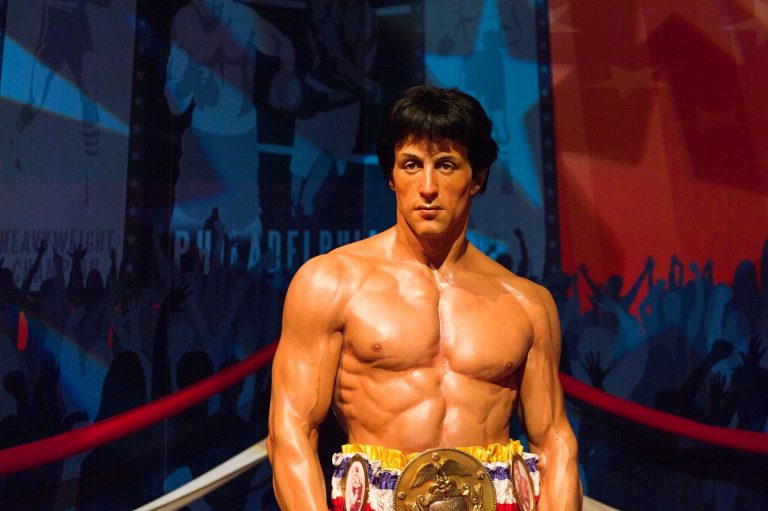Does Boxing Build Muscle? (Guide & 4 Key Exercises)
Despite its dated reputation for being only for men who like to fight, boxing has modernised quickly and is a great, approachable sport for people of all ages and abilities. It’s easy to guess that boxing is perfect for cardio and general fitness, but does boxing build muscle?
The quick answer is no, the act of boxing alone does not build muscle. However, boxing training 100% builds muscle! Boxing is an excellent way to train your whole body, and boxing training involves a whole host of different muscles.
Today, we’ll discuss the way in which boxing can help you build muscle, the muscle groups it is particularly good for, and 4 key boxing training exercises which focus on building specific muscles.
Boxing: Effects On The Body
Before looking at the way in which boxing can help to build muscle effectively, it can be useful to know a little more about how boxing can affect your body.
Cardiovascular System
Starting out simple is a vital first step, focusing on stance, form and general fitness. It is important to consider your cardiovascular system when starting a new sport. This system comprises organs including the heart and lungs, as well as muscles. Building up your cardiovascular system will help you box more effectively, improving the force and speed of the strikes you make and increasing your endurance.
Boxing training will increase your cardio endurance through strengthening your heart, lungs, and muscles, and increasing the flow of blood (and therefore oxygen) to the muscles. It can also help to control blood pressure and reduce the risk of diseases including heart disease and type 2 diabetes.
These benefits are gained from the range of exercises you undertake when you train for boxing. Some of these include jumping rope, circuit training, and using exercise bikes and treadmills.
Fat Loss
Through improving your cardio endurance and building muscle, a natural result of boxing training is loss of fat. Often training involves strenuous exercise which helps to build your metabolism and also to lose fat.
A person can burn somewhere between 400 and 700 calories while training using a heavyweight bag for just one hour!
Does Boxing Build Muscle?
Boxing training will definitely help you to build muscle, yes! Boxing itself however, the act of boxing taken alone, will not directly build muscle.
To explain this we need to look at the basics of muscle building, namely the three mechanisms of muscle building: mechanical tension, muscle injury, and metabolic stress.
These key processes build muscle through training a full range of motion, increasing the load of exercises, and increasing the repetition of exercises among other training elements.
The act of boxing in itself – fighting in matches or training on the bag – will not help to build muscle because it will not stimulate enough muscular tension or metabolic stress. In other words, resistance training is required as a standard part of boxing training in order to build up muscle and produce adequate force to become effective as a boxer.
Which Muscles Does Boxing Build?
You might think that boxing is simply an upper body sport, focusing heavily on the arms and hands. However, when practiced and trained for properly, boxing is a full-body sport.
Let’s take a look at some of the key muscles that can be built through boxing training, and which are required to become a successful boxer…
Calves
Calves are key muscles which help boxers to generate power behind a punch. Transferring weight from your heels to your toes help you to launch from the ground, building momentum and increasing the strength of a strike.
Footwork is another key element of boxing, and calf endurance will improve your footwork as you move around the ring.
Hips And Legs
The muscles located in your thighs and hips are massive! Specifically, the quadriceps and hamstrings (located in the thigh) are important muscles when it comes to boxing. These muscles aid the velocity behind a punch, generating power. Your leg muscles push you off the ground and drive power through your entire body as you fight.
Building the strength of your hips is an advantage which is often overlooked when it comes to boxing training. Your hips help you to pivot, generating power behind strikes. Strong hip muscles improve your balance, increasing your fighting efficiency. This can improve everything from moving quickly to both defense and offense skills.
All of the top professional boxers have incredibly strong legs aimed at increasing their fighting power.
Core
The core covers a whole range of muscles which run between the hips and shoulders. Most people think of the abs and perhaps the back muscles when they hear the word core. While it is useful to build these muscles when training for boxing, it is important not to overlook the whole set of core muscles.
Your core is an incredible centre of power within your body, linking all other key muscles together. This helps to combine the power and strength each muscle contributes into one total force. This set of muscles increase rotational power when striking and defending. The stronger your core, the more force you will generate behind punches.
A strong core is also vital to prevent injury through over-working single muscles such as your shoulder muscles. It helps to support your muscle network. Additionally, a strong core aids breathing while undertaking intense exercise, and receiving frontal body shots – it can help protect you from impacts.
Your back muscles, a big part of the core, are essential for stability and for setting up and throwing punches quickly.
Shoulders
It is common for a good boxing workout to result in aching shoulders – this is a good thing, it means you’ve really been working those shoulder muscles. It obviously not a good thing if you experience actual pain which indicates you have done something wrong or overdone it. In this case you should consult a physio therapist or good boxing trainer.
Due to the high frequency of punching involved in boxing, a lot of the power you generate with other muscles works through the shoulder joints. This makes shoulder muscles key for strike endurance. When you are too tired to hold your hands up in defense or throw a punch it is often because the shoulder muscles do not have the required endurance.
Your shoulder muscles help to hold up your entire arm, making them vital for boxing stance and technique.
Arms
Similarly to the shoulder muscles, the arm muscles are at the forefront of boxing. They work through everything from curling your hand to make a fist all the way through to extending and retracting the arm in defensive and offensive moves.
Arm muscles are not responsible for generating the power behind a strike, they help to bring the force generated by other muscles through to the opponent. Despite popular belief, boxing is not all about the arms! In fact, while it is important to have strong arm muscles, it is more important to have fast arms. This means they shouldn’t actually be bulging with muscle!
Small Muscles
Although small, there are a few vital muscles that are key to strengthening your body and preventing injury. For example, strong neck muscles help you to resist punches and avoid whiplash. Boxers are particularly vulnerable to injuring their necks and therefore many professional fighters work hard to strengthen the neck muscles.
The muscles that comprise and help tighten your fist within the glove are also important. Generally, the tighter the fist the more solid the punch and the less risk of injury to the hand.
Boxing Training Exercises To Help Build Muscles
There are some key exercises you can incorporate into your workout routine which are a vital part of any boxing training regime. We have picked out 4 useful exercises to help you build 4 specific muscle groups for boxing.
1. Jumping Rope
This is perhaps one of the most infamous exercises undertaken by boxers. Jumping rope is both effective in building calf and core muscles, and a lot of fun!
Jumping rope can be mixed up in a variety of ways to keep it fresh and interesting, while building vital muscles for boxing. Once you have mastered basic jumps, you can try out alternate foot jumps, high knees, side swings, and so many more! See here for jump rope inspiration.
2. Lunges
This classic exercise has great application in boxing training. Lunges help to strengthen the leg muscles. Once you get used to lunge repetitions, you can add extras like dumbell lunges. To train your hip muscles too, and increase your rotational power you can try lunge and rotate.
3. Sit-ups
One of the classic ab-building exercises, sit-ups help to strengthen your core muscles. This is particularly helpful for when you start sparring. Ensure you are doing this exercise correctly, concentrate on form to get the most from this exercise.
4. Weight Training
To strengthen your shoulder and arm muscles, you can try some targeted weight training. This will help improve your stamina when going through your boxing workout routine, and when sparring. There are a whole range of weight training exercises that can be done to improve your boxing technique and build key muscles. Try a staged shoulder workout incorporating several exercises, making sure you start out small and focus on form to minimise injuries.
Also Read:







